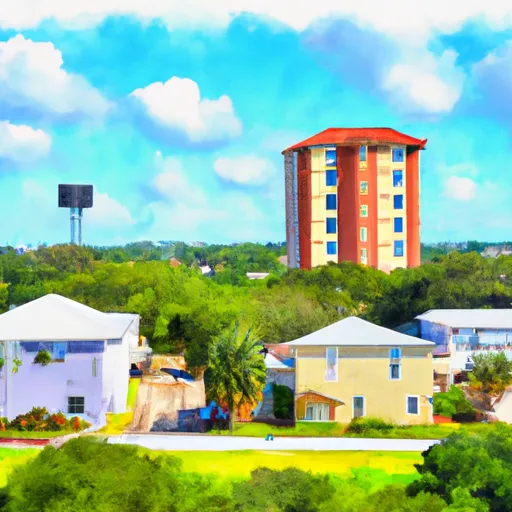-
 Snoflo Premium
Snoflo Premium
Get unlimited access to all our content
With no Ad interruptions! - Start Your Free Trial Login with existing account
Howey-In-The-Hil
Eden Index
Climate
7.1
•
Recreation
4.8
•
Community
2.2
•
Safeguard
5.1/10

Howey-In-The-Hills is a small town located in Central Florida, known for its picturesque landscapes and outdoor recreational opportunities. The climate in Howey-In-The-Hills is typically warm and humid, with hot summers and mild winters. The area experiences abundant rainfall throughout the year.
The town is surrounded by beautiful lakes, including Little Lake Harris and Lake Harris, which are part of the Harris Chain of Lakes. These lakes provide a variety of hydrology constituents, including diverse aquatic plant life and a thriving fish population. Anglers can enjoy fishing for bass, crappie, and catfish in these lakes.
Outdoor recreation enthusiasts can take advantage of the natural beauty in and around Howey-In-The-Hills. Boating, kayaking, and paddleboarding are popular activities on the lakes. The area also offers scenic trails for hiking and biking, allowing visitors to explore the serene landscapes and spot local wildlife. Golf lovers can enjoy the renowned Mission Inn Resort and Club, which features two championship golf courses.
In summary, Howey-In-The-Hills, Florida, offers a pleasant climate, abundant water resources, and a range of outdoor recreational opportunities, making it a desirable destination for nature lovers and adventure seekers.
What is the Eden Index?
The Snoflo Eden Index serves as a comprehensive rating system for regions, evaluating their desirability through a holistic assessment of climate health, outdoor recreation opportunities, and natural disaster risk, acknowledging the profound impact of these factors on livability and well-being.
Climate Health Indicator (CHI): 7.1
Howey-In-The-Hil receives approximately
1279mm of rain per year,
with humidity levels near 88%
and air temperatures averaging around
22°C.
Howey-In-The-Hil has a plant hardyness factor of
9, meaning
plants and agriculture in this region tend to thrive here all year round.
By considering the ideal temperature range, reliable water supplies, clean air, and stable seasonal rain or snowpacks, the Climate Health Indicator (CHI) underscores the significance of a healthy climate as the foundation for quality living.
A healthy climate is paramount for ensuring a high quality of life and livability in a region, fostering both physical well-being and environmental harmony. This can be characterized by ideal temperatures, reliable access to water supplies, clean air, and consistent seasonal rain or snowpacks.
Weather Forecast
Streamflow Conditions
St. Johns
Area Rivers
St. Johns
Snowpack Depths
St. Johns
Reservoir Storage Capacity
St. Johns
Groundwater Levels
Recreational Opportunity Index (ROI): 4.8
The Recreational Opportunity Index (ROI) recognizes the value of outdoor recreational options, such as parks, hiking trails, camping sites, and fishing spots, while acknowledging that climate plays a pivotal role in ensuring the comfort and consistency of these experiences.
Access to outdoor recreational opportunities, encompassing activities such as parks, hiking, camping, and fishing, is crucial for overall well-being, and the climate plays a pivotal role in enabling and enhancing these experiences, ensuring that individuals can engage in nature-based activities comfortably and consistently.
Camping Areas
| Campground | Campsites | Reservations | Toilets | Showers | Elevation |
|---|---|---|---|---|---|
| Alexander Springs | 181 | 49 ft | |||
| Fore Lake | 100 | 82 ft | |||
| Gores Landing County Park | None | 31 ft | |||
| Big Bass | 34 | 69 ft | |||
| Lake Griffin State Rec Area | None | 85 ft | |||
| Big Scrub | 50 | 145 ft | |||
| Hopkins Prairie | 21 | 35 ft | |||
| Trimble County Park | 15 | 65 ft | |||
| Saddle Creek County Park | None | 111 ft | |||
| Lake Louisa State Park | None | 154 ft |
Catastrophe Safeguard Index (CSI):
The Catastrophe Safeguard Index (CSI) recognizes that natural disaster risk, encompassing floods, fires, hurricanes, and tornadoes, can drastically affect safety and the overall appeal of an area.
The level of natural disaster risk in a region significantly affects safety and the overall livability, with climate change amplifying these risks by potentially increasing the frequency and intensity of events like floods, fires, hurricanes, and tornadoes, thereby posing substantial challenges to community resilience and well-being.
Community Resilience Indicator (CRI): 2.2
The Community Resilience Indicator (CRI) recognizes that education, healthcare, and socioeconomics are crucial to the well-being of a region. The CRI acknowledges the profound impact of these elements on residents' overall quality of life. By evaluating educational resources, healthcare accessibility, and economic inclusivity, the index captures the essential aspects that contribute to a thriving community, fostering resident satisfaction, equity, and social cohesion.

